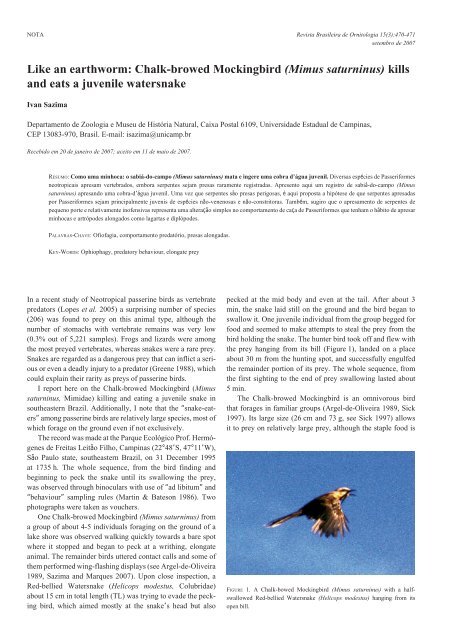You also want an ePaper? Increase the reach of your titles
YUMPU automatically turns print PDFs into web optimized ePapers that Google loves.
470 NOTA<br />
Ivan Sazima Revista Brasileira de Ornitologia 15(3):470-471<br />
setembro de 2007<br />
Like an earthworm: Chalk-browed Mockingbird (Mimus saturninus) kills<br />
and eats a juvenile watersnake<br />
Ivan Sazima<br />
Departamento de Zoologia e Museu de História Natural, Caixa Postal 6109, Universi<strong>da</strong>de Estadual de Campinas,<br />
CEP 13083‑970, Brasil. E‑mail: isazima@unicamp.br<br />
Recebido em 20 de janeiro de 2007; aceito em 11 de maio de 2007.<br />
Resumo: Como uma minhoca: o sabiá-do-campo (Mimus saturninus) mata e ingere uma cobra d’água juvenil. Diversas espécies de Passeriformes<br />
neotropicais apresam vertebrados, embora serpentes sejam presas raramente registra<strong>da</strong>s. Apresento aqui um registro de sabiá‑do‑campo (Mimus<br />
saturninus) apresando uma cobra‑d’água juvenil. Uma vez que serpentes são presas perigosas, é aqui proposta a hipótese de que serpentes apresa<strong>da</strong>s<br />
por Passeriformes sejam principalmente juvenis de espécies não‑venenosas e não‑constritoras. Também, sugiro que o apresamento de serpentes de<br />
pequeno porte e relativamente inofensivas representa uma alteração simples no comportamento de caça de Passeriformes que tenham o hábito de apresar<br />
minhocas e artrópodes alongados como lagartas e diplópodes.<br />
PalavRas-Chave: Ofiofagia, comportamento pre<strong>da</strong>tório, presas alonga<strong>da</strong>s.<br />
Key-WoRds: Ophiophagy, pre<strong>da</strong>tory behaviour, elongate prey<br />
In a recent study of Neotropical passerine birds as vertebrate<br />
pre<strong>da</strong>tors (Lopes et al. 2005) a surprising number of species<br />
(206) was found to prey on this animal type, although the<br />
number of stomachs with vertebrate remains was very low<br />
(0.3% out of 5,221 samples). Frogs and lizards were among<br />
the most preyed vertebrates, whereas snakes were a rare prey.<br />
Snakes are regarded as a <strong>da</strong>ngerous prey that can inflict a seri‑<br />
ous or even a deadly injury to a pre<strong>da</strong>tor (Greene 1988), which<br />
could explain their rarity as preys of passerine birds.<br />
I report here on the Chalk‑browed Mockingbird (Mimus<br />
saturninus, Mimi<strong>da</strong>e) killing and eating a juvenile snake in<br />
southeastern Brazil. Additionally, I note that the “snake‑eat‑<br />
ers” among passerine birds are relatively large species, most of<br />
which forage on the ground even if not exclusively.<br />
The record was made at the Parque Ecológico Prof. Hermó‑<br />
genes de Freitas Leitão Filho, Campinas (22°48’S, 47°11’W),<br />
São Paulo state, southeastern Brazil, on 31 December 1995<br />
at 1735 h. The whole sequence, from the bird finding and<br />
beginning to peck the snake until its swallowing the prey,<br />
was observed through binoculars with use of “ad libitum” and<br />
“behaviour” sampling rules (Martin & Bateson 1986). Two<br />
photographs were taken as vouchers.<br />
One Chalk‑browed Mockingbird (Mimus saturninus) from<br />
a group of about 4‑5 individuals foraging on the ground of a<br />
lake shore was observed walking quickly towards a bare spot<br />
where it stopped and began to peck at a writhing, elongate<br />
animal. The remainder birds uttered contact calls and some of<br />
them performed wing‑flashing displays (see Argel‑de‑Oliveira<br />
1989, Sazima and Marques 2007). Upon close inspection, a<br />
Red‑bellied Watersnake (Helicops modestus, Colubri<strong>da</strong>e)<br />
about 15 cm in total length (TL) was trying to evade the peck‑<br />
ing bird, which aimed mostly at the snake’s head but also<br />
pecked at the mid body and even at the tail. After about 3<br />
min, the snake laid still on the ground and the bird began to<br />
swallow it. One juvenile individual from the group begged for<br />
food and seemed to make attempts to steal the prey from the<br />
bird holding the snake. The hunter bird took off and flew with<br />
the prey hanging from its bill (Figure 1), landed on a place<br />
about 30 m from the hunting spot, and successfully engulfed<br />
the remainder portion of its prey. The whole sequence, from<br />
the first sighting to the end of prey swallowing lasted about<br />
5 min.<br />
The Chalk‑browed Mockingbird is an omnivorous bird<br />
that forages in familiar groups (Argel‑de‑Oliveira 1989, Sick<br />
1997). Its large size (26 cm and 73 g, see Sick 1997) allows<br />
it to prey on relatively large prey, although the staple food is<br />
FiguRe 1. A Chalk‑bowed Mockingbird (Mimus saturninus) with a half‑<br />
swallowed Red‑bellied Watersnake (Helicops modestus) hanging from its<br />
open bill.

















